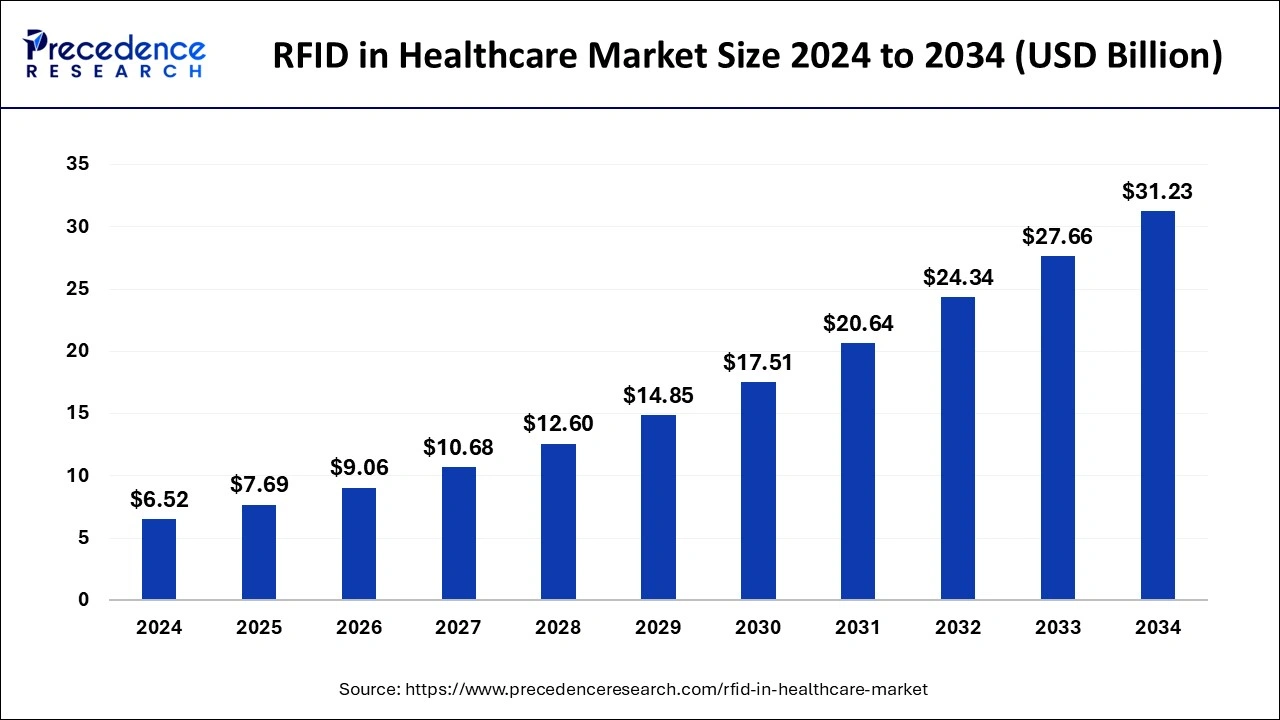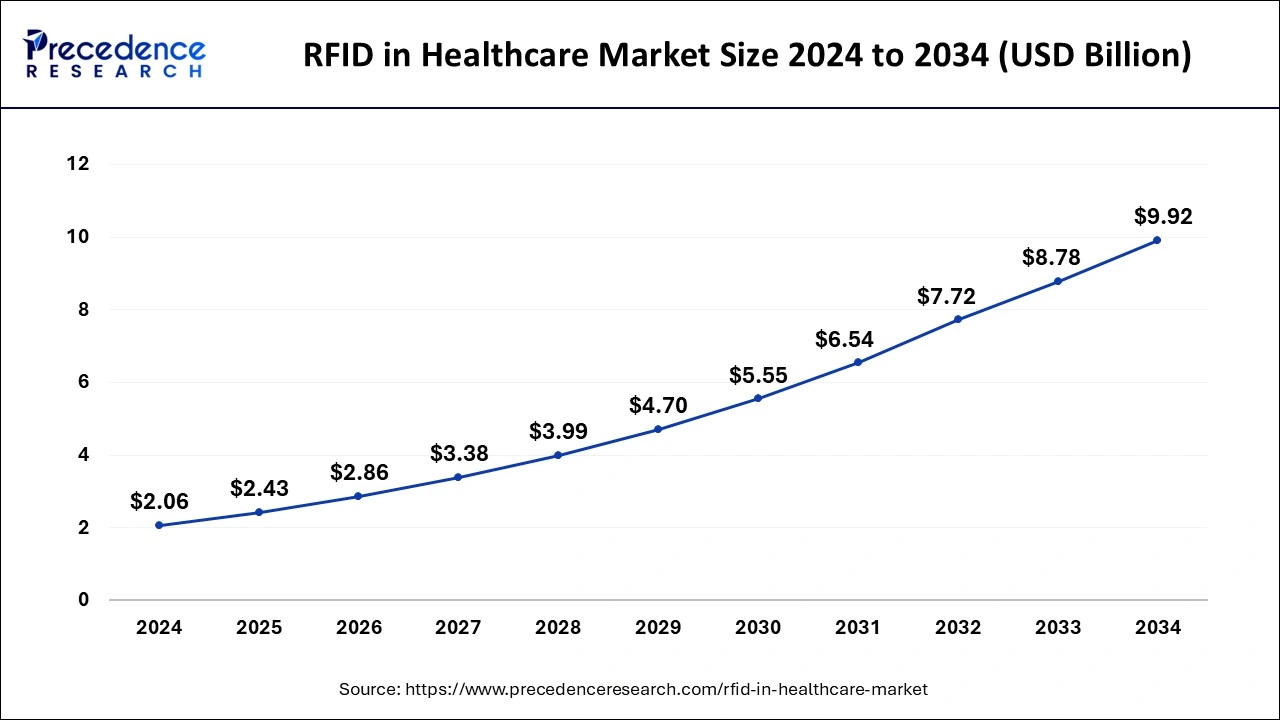What is RFID in Healthcare Market Size?
The global RFID in healthcare market size accounted for USD 7.69 billion in 2025 and is predicted to reach around USD 31.23 billion by 2034, growing at a CAGR of 16.96% from 2025 to 2034.

Market Highlights
- North America led the global market with the highest market share in 2024.
- The Asia Pacific region is estimated to expand the fastest CAGR between 2025 and 2034.
- By Product, The tags segment captured the biggest revenue share in 2024.
- By Application, the pharmaceutical tracking segment registered the maximum market share in 2024.
RFID in Healthcare Market Growth Factors
RFID technology in the healthcare sector is predicted to witness outstanding growth in the near future. Some of the prominent factors accelerating the growth of Improvement RFID in the Healthcare market include inventory management in pharmacies, hospitals, and biotechnology companies, and enhanced patient security by healthcare providers. Further, the high efficiency and low cost of RFID systems and the implementation of automated processes in pharmacies and hospitals are spurring market demand. Also, intensifying research and development operations by non-profit organizations and rigorous strategies adopted by top participants like expansion, mergers, and partnership for the development of new-fangled technologies to reinforce RFID in healthcare also improve the growth of the market. For illustration, Harland Simon, a chief provider of location tracking solutions partnered with PervasID for presenting novel RFID reader technology to the market. It is a Cambridge-based and award-winning technology firm.
The Growing requirement to avert expiry, spoilage, and counterfeit products from coming into the market and the cumulative requirement to help adhere to the FDA's Drug Supply Chain Security Act, MHRA, and other regulatory establishments. The growth of this market is powered by the snowballing installation of RFID in manufacturing units for efficiency enhancement; augmented practice of access and security control applications and swelling government initiatives. Huge implementation of RFID technology in the retail sector, and development in the RFID ecosystem via organic growth strategies like acquisitions and mergers, and collaborations further aid in market progression.
However, a few limiting aspects for the development of the healthcare RFID market are more installation cost of RFID systems in healthcare and systems interoperability. RFID adoption in any industry needs huge investments for readers, tags, software, electricity, and running replacement services. Further additional features like Internet of Things integration, accuracy checking of the system, and training charges increase expenses for RFID solutions.
Market Outlook
- Industry Growth Offerings- Industry growth in the market is fueled by real-time asset and patient tracking, secure medication monitoring, and automated inventory control. Providers are deploying RFID systems to enhance safety, reduce errors, streamline workflows, and improve supply chain visibility.
- Global Expansion- Global expansion of the market is driven by rising demand for smart hospital infrastructure, regulations on drug traceability, and investments in digital healthcare. Major regions like North America, Asia Pacific, and Europe are rapidly adopting RFID for asset tracking, patient management, and secure supply chains.
- Startup ecosystem- Startups in the market, such as Spacecode, Biolog ID, and MetraTec—are developing innovative RTLS modules, RFID LED hybrid tags, and wearable tracking devices. Their solutions improve inventory visibility, patient safety, and real-time asset management in hospitals.
Market Scope
| Report Coverage | Details |
| Market Size in 2025 | USD 7.69 Billion |
| Market Size in 2026 | USD 9.06 Billion |
| Market Size by 2034 | USD 31.23 Billion |
| Growth Rate From 2025 to 2034 | CAGR of 16.96% |
| Largest Market | North America |
| Base Year | 2024 |
| Forecast Period | 2025 to 2034 |
| Segments Covered | Product, Application and Region |
| Regional Scope | North America, APAC, Europe, Latin America, MEAN, |
Segment Insights
Product Insights
Different products in the healthcare RFID product market comprise monitors, RFID tags, printers, software, and readers among others. RFID tags can be employed for pharmaceutical and asset tracking, and patient and blood monitoring systems tracking. Whereas the hardware and software are employed for displaying and reading the information on the RFID tags. Among product segmentation, RFID systems are projected to grasp the principal market stake over the prediction period. These systems are normally employed for equipment, personnel, and inventory tracking in healthcare settings and in hospitals. Additionally, these systems are employed for patient monitoring and to avert the distribution of forged devices and drugs.
Owed to features such as low cost, small size, and extended lifetime, passive tags are anticipated to gain more grip compared to active tags. Passive UHF RFID tags have also observed a large acceptance after the development of the RAIN RFID alliance. With members like AIDC industry association AIM Global, Impinj, Google, Intel and SMARTRAC, the alliance has efficiently worked on a spread of alertness among the users and probable customers.
Application Insights
Different applications assessed in RFID in healthcare market reports are tracking and monitoring. Pharmaceutical tracking application generates prominent revenue due to the growing acceptance of the technology to recognize counterfeit drugs. Pharmaceutical tracking systems are measured as helpful to patients, organizations, and supply chain partners. In recent times, there has been an upsurge in the propagation and distribution of forged drugs that stance an augmented risk for health hazards.
The RFID technology supports in detection and screening of such drugs and aid in ceasing the spreading in the market. Besides, this technology helps pharmaceutical companies with efficient inventory managing tasks and minimalizing labeling blunders. These compensations help lessen the waste and thus cut the undesirable costs incurred.
Regional Insights
U.S. RFID In Healthcare Market Size and Growth 2025 To 2034
The U.S. RFID in healthcare market size is valued at USD 2.43 billion in 2025 and is expected to reach USD 9.92 billion by 2034, growing at a CAGR of 17.04% from 2025 to 2034.

North America Leads Global Healthcare RFID Market Amid Growing Adoption and Innovation
North America dominated the global healthcare RFID marketplace due to the cumulative number of hospitals and the existence of regulations on patient safety. Europe can be assumed to be the second-most profitable market for healthcare RFID systems. The regional market benefits from promising government support in terms of funding and rigorous support of the development of the healthcare sector. Moreover, growing research and development in the region offers lucrative avenues for market expansion in the near future.
In the North American region, the United States and Canada are the major contributors to the market. These countries has the presence of extensive healthcare network, technological readiness, rising healthcare expenditure, growing adoption of advanced medical technology, and increased focus on improving patient care efficiency.
The implementation of RFID systems in healthcare facilities assists in track equipment and supplies, manage patients and personnel, and significantly minimizes the medication-related errors. The market has observed the significant rise in the adoption of RFID technology by healthcare providers into their workflows to improve healthcare service delivery.
- In September 2024, Oracle announced a new replenishment solution in Oracle Fusion Cloud Supply Chain & Manufacturing (SCM) to help healthcare customers optimize inventory management. The new RFID for Replenishment solution in Oracle Fusion Cloud Inventory Management utilizes RFID technologies to automatically capture usage, update stock balances, track location, and trigger restocking of supplies and materials.

Rapid RFID Expansion in Asia Pacific Revolutionizes Healthcare Operations
Asia Pacific is anticipated to be the fastest budding healthcare RFID market throughout the estimated period on account of refining healthcare infrastructure, increasing investments in the healthcare sector, and developments by market participants in the region. Also, nations such as China and India are seeing the fastest progressions owing to the growing government emphasis on implementation of novel technology, and the finest treatment selection from a developed country.
The RFID applications are extensively being utilized by the healthcare sector ranging from patient monitoring and medical equipment tracking to inventory management and medication administration. In the Asia Pacific region, the implementation of RFID solutions in healthcare has increased significantly, for better patient care & safety, streamline workflows, and optimize resource utilization.
Why is the U.S. RFID in Healthcare Market Growing Rapidly?
The U.S. market is growing due to increasing adoption of RFID technology for real-time asset tracking, reducing equipment loss, and improving inventory management. Hospitals are leveraging RFID for patient safety, medication tracking, and regulatory compliance. Integration with automated pharmacy systems and workflow optimization further enhances operational efficiency. Rising awareness of technology benefits and the push for cost-effective healthcare solutions are driving market expansion.
What is Driving the Expansion of RFID in China's Healthcare Market?
The China market is expanding due to rising demand for real-time tracking of hospital assets, patients, and medications. Government initiatives like “Healthy China 2030” support smart hospital development, while strict drug traceability regulations drive adoption. Integration with IoT and AI enhances operational efficiency, reduces errors, and prevents counterfeiting, making RFID solutions increasingly essential for modern healthcare facilities across China.
Why is RFID Adoption Increasing Across Europe's Healthcare Sector?
Europe's market is growing due to strict regulations like the Falsified Medicines Directive, driving pharmaceutical traceability. Advanced hospital infrastructure and strong investment in smart hospital initiatives support real-time asset and patient tracking. RFID's integration with IoT and AI enables better workflow automation and predictive maintenance. Focus on patient safety and inventory transparency further accelerates adoption.
How is RFID Transformation Healthcare Operations in the UK?
The UK market is growing due to rising adoption of real-time asset tracking systems across hospitals, which improves equipment utilization and reduces costs. RFID wristbands are increasingly used for patient identification and safety. Regulatory drivers around drug traceability and compliance also boost demand. Integration with IoT and smart hospital initiatives further accelerates RFID implementation across the NHS and private providers.
Value Chain Analysis
- Regulatory Approvals
Compliance involves medical device regulations, RF spectrum allocations, and data privacy laws to ensure safe and legal use.
Approval processes vary by region, such as FDA regulations in the U.S. and CE marking in Europe.
Ensures secure patient data management, safe device operation, and adherence to regional standards.
Key Players: Zebra Technologies, Avery Dennison, Impinj, Honeywell International, Alien Technology. - Distribution to Hospitals, Pharmacies
Enhances supply chain management via real-time tracking, inventory control, and security.
Tags medications, high-value instruments, and supplies to prevent counterfeiting and track expiration dates.
Automates processes like inventory counts and item-level tracking for operational efficiency.
Provides end-to-end visibility, supports regulatory compliance, and reduces manual errors.
Key Players: Impinj, Honeywell International, Alien Technology, Avery Dennison. - Patient Support and Services
Enhances patient safety by enabling accurate identification and monitoring.
Improves care coordination through real-time tracking of patients, staff, and equipment.
Supports personalized services and creates a more efficient hospital environment.
Focuses on workflow optimization rather than direct medical care.
Key Players: Zebra Technologies, Impinj, Honeywell International, Alien Technology, Avery Dennison.
Key Players in RFID in Healthcare Market and their Offerings
- CenTrak / CenTrak (Cebtrack): Deploys RTLS and RFID systems for real-time hospital asset tracking, safety monitoring, and workflow optimization.
- Impinj: Provides RAIN RFID platforms for hospitals to automate asset management, inventory tracking, and patient flow with real-time tracking.
- Biolog ID: Offers RFID-based traceability for blood products, oncology drugs, and plasma through its end-to-end transfusion management solution.
- Spacecode (Spacetime): Delivers RFID + LED tag systems for inventory control in blood banks, labs, cath labs, and pharmacies.
- MetraTec GmbH: Develops embedded RFID and RTLS modules (OEM) and wearable devices for real-time identification and tracking of medical staff, assets, and patients.
Segments Covered in the Report
By Product
- Tags
- Systems & Software
By Application
- Pharmaceutical Tracking
- Asset Tracking
- Patient Tracking
- Blood Tracking
- Others
By Region
- North America
- Europe
- Asia-Pacific
- Latin America
- Middle East & Africa
For inquiries regarding discounts, bulk purchases, or customization requests, please contact us at sales@precedenceresearch.com
Frequently Asked Questions
Ask For Sample
No cookie-cutter, only authentic analysis – take the 1st step to become a Precedence Research client
 sales@precedenceresearch.com
sales@precedenceresearch.com
 +1 804-441-9344
+1 804-441-9344



